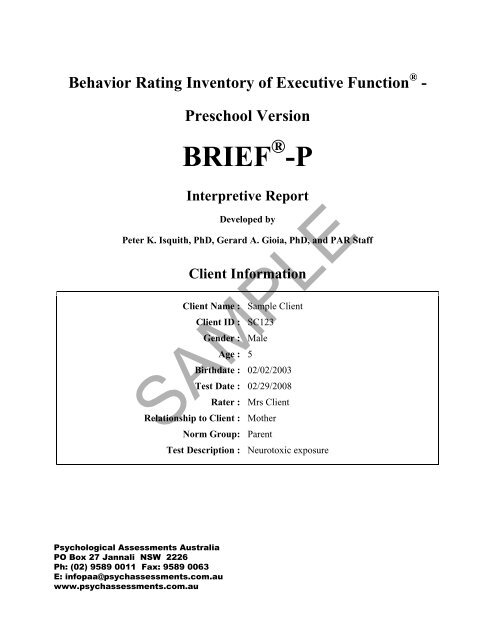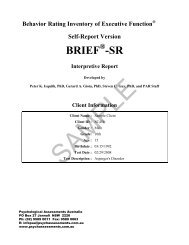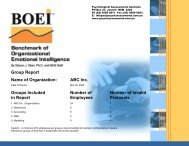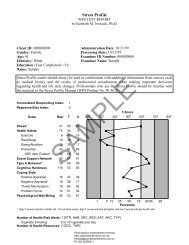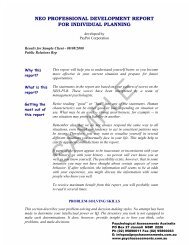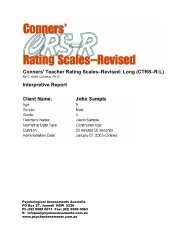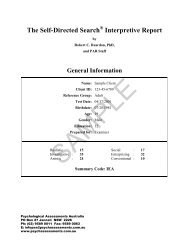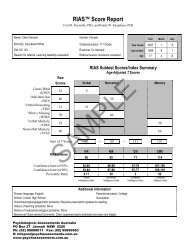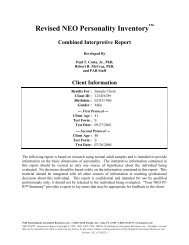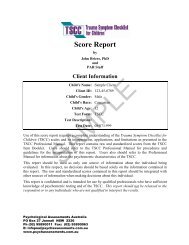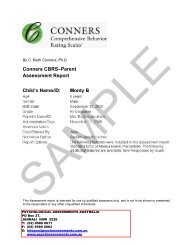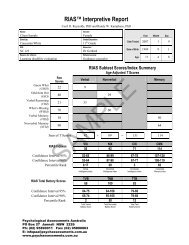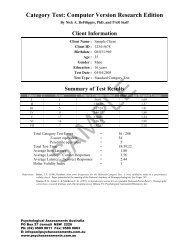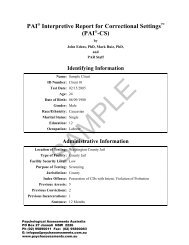BRIEF-P SP Interpretive Report - Psychological Assessments Australia
BRIEF-P SP Interpretive Report - Psychological Assessments Australia
BRIEF-P SP Interpretive Report - Psychological Assessments Australia
You also want an ePaper? Increase the reach of your titles
YUMPU automatically turns print PDFs into web optimized ePapers that Google loves.
Behavior Rating Inventory of Executive Function ® -Preschool Version<strong>BRIEF</strong> ® -P<strong>Interpretive</strong> <strong>Report</strong>Developed byPeter K. Isquith, PhD, Gerard A. Gioia, PhD, and PAR StaffClient InformationClient Name : Sample ClientClient ID : SC123Gender : MaleAge : 5Birthdate : 02/02/2003Test Date : 02/29/2008Rater : Mrs ClientRelationship to Client : MotherNorm Group: ParentTest Description : Neurotoxic exposureSAMPLEPAR <strong>Psychological</strong> Assessment Resources, Inc. / 16204 North Florida Ave. / Lutz, FL 33549 / 1.800.331.8378 / www.parinc.com<strong>BRIEF</strong> ® -P: <strong>Interpretive</strong> <strong>Report</strong> Copyright © 1996, 1998, 2000, 2001, 2002, 2003, 2004, 2007, 2008 by <strong>Psychological</strong> Assessment Resources, Inc.All rights reserved. May not be reproduced in whole or in part in any form or by any means without written permission of <strong>Psychological</strong>Assessment Resources, Inc.Version: 3.01.007
Client: Sample Client Test Date: 02/29/2008Client ID: SC123 Page 2 of 9IntroductionThe Behavior Rating Inventory of Executive Function–Preschool Version ® (<strong>BRIEF</strong> ® -P; Gioia,Espy, & Isquith, 2003) is a standardized rating scale developed to provide a window intoeveryday behaviors associated with specific domains of executive functioning in children aged 2to 5 years. The <strong>BRIEF</strong>-P consists of a single Rating Form, designed to be completed by parents,teachers, or other caregivers, with 63 items in five non-overlapping scales. The scales form aGlobal Executive Composite (GEC) and three overlapping summary indexes each with twoscales based on theoretical and statistical considerations. The Inhibitory Self-Control Index(ISCI) is composed of the Inhibit and Emotional Control scales, the Flexibility Index (FI) iscomposed of the Shift and Emotional Control scales, and the Emergent Metacognition Index(EMI) is composed of the Working Memory and Plan/Organize scales. There also are twoValidity scales: Negativity and Inconsistency. The <strong>BRIEF</strong>-P can serve as a screening tool forpossible executive function difficulties and as an index of the ecological validity of laboratory orclinic-based assessments.The clinical information gathered from an in-depth profile analysis on the <strong>BRIEF</strong>-P is bestunderstood within the context of a full assessment that includes (a) a detailed history of the child;(b) performance-based testing; (c) reports on the <strong>BRIEF</strong>-P from parents, teachers, and/or othercaregivers; and (d) observations of the child’s behavior. By examining converging evidence,the clinician can confidently arrive at a valid diagnosis and, most importantly, an effectivetreatment plan. A thorough understanding of the <strong>BRIEF</strong>-P, including its development and itspsychometric properties, is a prerequisite to interpretation. As with any clinical method orprocedure, proper training and clinical supervision is necessary to ensure competent use of the<strong>BRIEF</strong>-P.This report is confidential and intended for use by qualified professionals only. This reportshould not be released to the child being evaluated or to his parents, teachers, or otherinformants. If a summary of the results specifically written for the child’s informants isappropriate and desired, the <strong>BRIEF</strong>-P Feedback <strong>Report</strong> can be generated and given to theinterested parties, preferably in the context of verbal feedback and a review of the Feedback<strong>Report</strong> by the clinician.SAMPLET scores (M = 50, SD = 10) are used to interpret the child’s level of executive functioning on the<strong>BRIEF</strong>-P. These scores are transformations of the raw scale scores. T scores provideinformation about a child’s scores relative to the scores of children in the standardization sample.Traditionally, T scores at or above 65 are considered clinically significant. Percentiles representthe percentage of children in the standardization sample whose scores fall below a given rawscore. In the process of interpreting the <strong>BRIEF</strong>-P, review of individual items within each scalecan yield useful information for understanding the specific nature of the individual’s elevatedscore on any given Clinical scale. Although certain items may have considerable clinicalrelevance for the child being evaluated, placing too much interpretive significance on individualitems is not recommended due to lower reliability of individual items relative to the scales andindexes.
Client: Sample Client Test Date: 02/29/2008Client ID: SC123 Page 3 of 9OverviewSample's mother completed the Behavior Rating Inventory of Executive Function-PreschoolVersion (<strong>BRIEF</strong>-P) on 02/29/2008.There are no missing item responses in the protocol. Ratings of Sample's self-regulation do notappear overly negative. Responses are reasonably consistent. In the context of these validityconsiderations, ratings of Sample's everyday executive function suggest some areas of concern.The overall index, the Global Executive Composite (GEC), was elevated (GEC T = 79, %ile =99). The Inhibitory Self-Control Index (ISCI), Flexibility Index (FI), and EmergentMetacognition Index (EMI) were elevated (ISCI T = 82, %ile = 99; FI T = 74, %ile = 96; EMI T= 72, %ile = 97).Within these summary indicators, all of the individual scales are valid. One or more of theindividual <strong>BRIEF</strong>-P scales were elevated, suggesting that Sample is described as havingdifficulty with some aspects of executive function. Concerns are noted with his ability to inhibitimpulsive responses, modulate emotions, sustain working memory, and plan and organizeproblem solving approaches. Sample's ability to adjust to changes in routine or task demandsis not described as problematic.Current models of self-regulation suggest that behavioral regulation, particularly inhibitorycontrol, underlies most other areas of executive function. Essentially, one needs to beappropriately inhibited, flexible, and under emotional control for efficient, systematic, andorganized problem-solving to take place. Sample's elevated scores on the Inhibit scale, and theInhibitory Self-Control and Emergent Metacognition Indexes, suggest that he is perceived ashaving poor inhibitory control and/or suggest that more global behavioral dysregulation is havinga negative effect on metacognitive aspects of executive function. The elevated InhibitorySelf-Control Index score, however, does not negate the meaningfulness of the elevated EmergentMetacognition Index score. Instead, one must consider the influence of the underlyingbehavioral regulation issues while simultaneously considering the unique problems with themetacognitive problem-solving skills.SAMPLE
Client: Sample Client Test Date: 02/29/2008Client ID: SC123 Page 4 of 9<strong>BRIEF</strong> ® -P Score Summary TableScale/Index Raw Score T Score Percentile 90% CIInhibit 40 78 99 73 - 83Shift 20 64 88 58 - 70Emotional Control 24 80 99 73 - 87Working Memory 32 68 94 62 - 74Plan/Organize 22 74 99 66 - 82Inhibitory Self-Control Index (ISCI) 64 82 99 77 - 87Flexibility Index (FI) 44 74 96 69 - 79Emergent Metacognition Index (EMI) 54 72 97 67 - 77Global Executive Composite (GEC) 138 79 99 75 - 83Validity Scale Raw Score Cumulative Percentile Protocol ClassificationNegativity 0 0 - 97 AcceptableInconsistency 6 0 - 94 AcceptableSAMPLE
Client: Sample Client Test Date: 02/29/2008Client ID: SC123 Page 5 of 9Profile of <strong>BRIEF</strong> ® -P T ScoresT Score 100T Score 1009595909085807570656055504540SAMPLE858075706560555045403535 30Inhibit Shift Emotional Working Plan / ISCI FI EMI GECControl Memory OrganizeT score 78 64 80 68 74 82 74 72 79Percentile 99 88 99 94 99 99 96 97 99Missing 0 0 0 0 0 0 0 0 0Note: Age-specific norms have been used to generate this profile.For additional normative information, refer to the Appendixes in the <strong>BRIEF</strong> ® -P Professional Manual. 30
Client: Sample Client Test Date: 02/29/2008Client ID: SC123 Page 6 of 9ValidityBefore examining the <strong>BRIEF</strong>-P profile, it is essential to carefully consider the validity of the dataprovided. The inherent nature of rating scales brings potential bias to the scores. The first stepis to examine the protocol for missing data. With a valid number of responses, the Negativityand Inconsistency scales of the <strong>BRIEF</strong>-P provide additional validity information.Missing ItemsThe respondent completed 63 of a possible 63 <strong>BRIEF</strong>-P items. There are no missing responsesin the protocol, providing a complete data set for interpretation.NegativityThe Negativity scale measures the extent to which the respondent answered selected <strong>BRIEF</strong>-Pitems in an unusually negative manner. Items composing the Negativity scale are shown in thesummary table below. A higher raw score on this scale indicates a greater degree of negativity,with less than 1% of respondents endorsing 4 or more of the items as Often in the combinedclinical and normative parent sample. T scores are not generated for this scale. The Negativityscore of 0 is within the acceptable range, suggesting that the respondent’s view of Sample is notoverly negative and that the <strong>BRIEF</strong>-P protocol is likely to be valid.InconsistencyScores on the Inconsistency scale indicate the extent to which similar <strong>BRIEF</strong>-P items wereendorsed in an inconsistent manner relative to the combined normative and mixed clinicalsamples. For example, a high Inconsistency score might be associated with marking Never inresponse to Item 1 (“Overreacts to small problems”) and simultaneously marking Often inresponse to Item 11 (“Becomes upset too easily”). T scores are not generated for theInconsistency scale. Instead, the raw difference scores for the 10 paired items are summed andthe total difference score (i.e., the Inconsistency score) is used to classify the protocol as either“Acceptable” or “Inconsistent.” The Inconsistency score of 6 is within the Acceptable range,suggesting that responses were reasonably consistent.SAMPLE
Client: Sample Client Test Date: 02/29/2008Client ID: SC123 Page 7 of 9Global Executive CompositeComposite and Summary IndexesThe Global Executive Composite (GEC) is an overarching summary score that incorporates allof the <strong>BRIEF</strong>-P Clinical scales. Although review of the Inhibitory Self-Control Index (ISCI),Flexibility Index (FI), Emergent Metacognition Index (EMI), and individual scale scores isstrongly recommended for all <strong>BRIEF</strong>-P profiles, the GEC can sometimes be useful as a summarymeasure. In this case, the three summary indexes are not substantially different. Thus, theGEC may adequately capture the nature of the overall profile. With this in mind, Sample's Tscore of 79 (%ile = 99) on the GEC is elevated as compared to the scores of his peers,suggesting perceived difficulty in one or more areas of executive function.Inhibitory Self-Control, Flexibility, and Emergent Metacognition IndexesThe Inhibitory Self-Control Index (ISCI) represents a child’s ability to modulate actions,responses, emotions, and behavior via appropriate inhibitory control. The index is composed ofthe Inhibit and Emotional Control scales. Appropriate inhibitory self-control is fundamental toemerging metacognitive problem-solving. Such behavioral regulation enables themetacognitive processes to support appropriate self-regulation and to guide active, systematicproblem-solving successfully.The Flexibility Index (FI) represents a child’s ability to move flexibly among actions, responses,emotions, and behavior. It is composed of the Shift and Emotional Control scales. Flexibilityis an important component of behavioral regulation, as indicated by the individual’s ability tomodulate behavioral and emotional reactions according to different response contingencies andenvironmental demands.The Emergent Metacognition Index (EMI) reflects a child’s ability to sustain ideas and activitiesin working memory and to plan and organize problem-solving approaches. It is composed ofthe Working Memory and Plan/Organize scales. As the young child becomes an active andeffective problem-solver, these systematic metacognitive functions become critically important.SAMPLEExamination of the indexes reveals that the Inhibitory Self-Control Index (ISCI), FlexibilityIndex (FI) and Emergent Metacognition Index (EMI) were elevated (ISCI T = 82, %ile = 99; FIT = 74, %ile = 96; EMI T = 72, %ile = 97). This suggests that Sample is viewed as havingglobal difficulties with self-regulation, including difficulty inhibiting impulses, modulatingemotions, adapting to change, sustaining working memory, and planning and organizingproblem-solving approaches relative to his peers.Clinical ScalesThe <strong>BRIEF</strong>-P Clinical scales measure the extent to which the respondent reports problems withdifferent behaviors related to the five domains of executive functioning captured within the<strong>BRIEF</strong>-P. The following sections describe the scores obtained on the Clinical scales and thesuggested interpretation for each individual Clinical scale.
Client: Sample Client Test Date: 02/29/2008Client ID: SC123 Page 8 of 9InhibitThe Inhibit scale assesses inhibitory control and impulsivity. This can be described as theability to resist impulses and the ability to stop one’s own behavior at the appropriate time.Sample's score on this scale is elevated (T = 78, %ile = 99) as compared to his peers. Thissuggests that he is viewed as having substantial difficulty resisting impulses and consideringconsequences before acting. Young children with reported difficulties on this scale may beperceived as (a) less “in control” of their behavior than their peers; (b) interrupting othersfrequently; (c) saying inappropriate things; and/or (d) restless or unable to sit still for appropriatelengths of time. Others may be concerned about verbal and social intrusiveness or a potentiallack of personal safety in individuals who have difficulty inhibiting impulses (Goldstrohm &Arffa, 2005). Examination of the individual items that compose the Inhibit scale may beinformative and may help guide interpretation and intervention.ShiftThe Shift scale assesses the ability to move freely from one situation, activity, or aspect of aproblem to another as the circumstances demand. Key aspects of shifting include the ability to(a) make transitions; (b) tolerate change; (c) problem-solve flexibly; and (d) switch or alternateattention. Sample's score on the Shift scale is within the average range as compared tolike-aged peers (T = 64, %ile = 88).Emotional ControlThe Emotional Control scale measures the impact of executive function difficulties on emotionalexpression and assesses a child’s ability to modulate or control his emotional responses.Sample's score on the Emotional Control scale is elevated as compared to like-aged peers (T =80, %ile = 99). This score suggests that there are concerns with regulation or modulation ofemotions. Sample is described as likely to overreact to events and as demonstrating suddenoutbursts, sudden and/or frequent mood changes, and excessive periods of emotional upset.Poor emotional control is often expressed as emotional lability, sudden outbursts, or emotionalexplosiveness. Individuals with difficulties in this domain often have overblown emotionalreactions to seemingly minor events.SAMPLEWorking MemoryThe Working Memory scale measures “on-line representational memory;” that is, the capacity tohold information in mind for the purpose of completing a task, encoding information, orgenerating goals, plans, and sequential steps to achieving goals. Working memory in youngchildren is essential to sustain problem-solving activities, carry out multistep activities, completebasic mental manipulations, and follow complex instructions. Sample's score on the WorkingMemory scale is elevated as compared to like-aged peers (T = 68, %ile = 94). This suggests thathe is described as having difficulty holding an appropriate amount of information in mind or in“active memory” for further processing, encoding, and/or mental manipulation. Further,
Client: Sample Client Test Date: 02/29/2008Client ID: SC123 Page 9 of 9elevations on this scale suggest difficulties sustaining working memory, which has a negativeimpact on the ability to remain attentive and focused for appropriate lengths of time. Youngchildren with fragile or limited working memory may have trouble remembering things (e.g.,instructions) even for a few seconds, keeping track of what they are doing as they work, or mayforget what they are supposed to retrieve when sent on an errand. They may miss informationthat exceeds their working memory capacity, such as multi-step instructions.Plan/OrganizeThe Plan/Organize scale measures the child’s ability to manage current and future-oriented taskdemands within the situational context. The scale consists of two task-related components:planning and organization. The plan component relates to the ability to anticipate future events,implement instructions or goals, and develop appropriate steps ahead of time in order to carry outa task or activity. In preschool children, developmentally appropriate planning often involvesimplementing a goal or end state (provided by the adult) by strategically selecting the mosteffective method or steps to attain that goal. Planning often requires sequencing or stringingtogether a series of actions or responses. The organize component refers to the ability to bringorder to information, actions, or materials to achieve a goal or to follow an established organizedroutine. Sample's score on the Plan/Organize scale is elevated as compared to like-aged peers(T = 74, %ile = 99). This suggests that he is perceived as having marked difficulty with theplanning and the organization of information, materials, or actions, which has a negative impacton his approach to problem-solving.Executive System InterventionSAMPLE(This section removed for sample report purposes)End of <strong>Report</strong>


